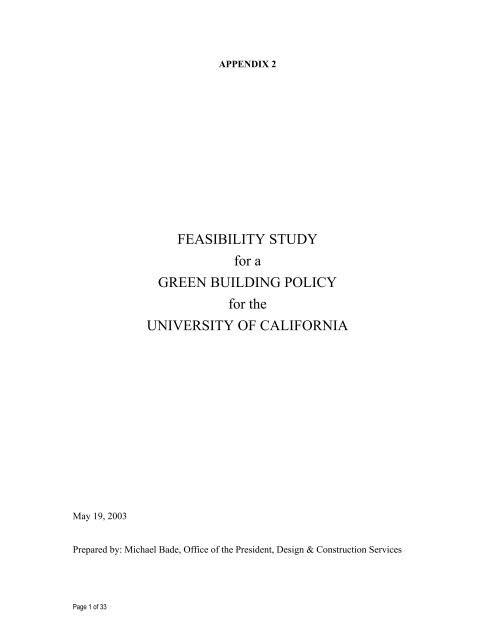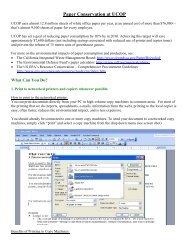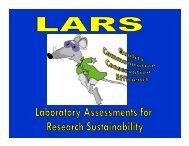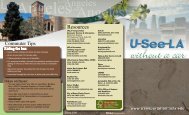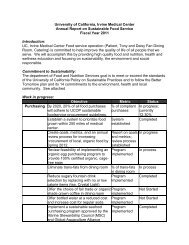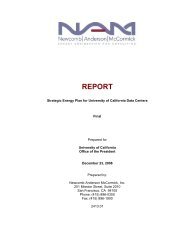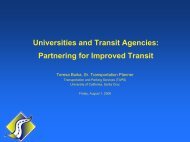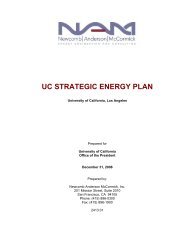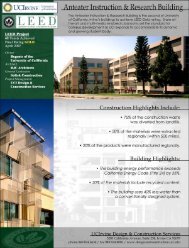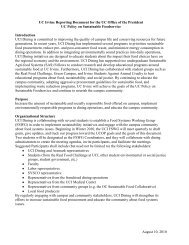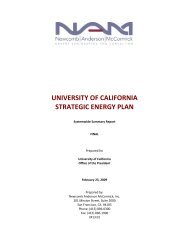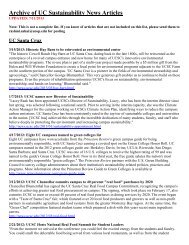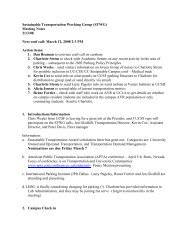FEASIBILITY STUDY for a GREEN BUILDING POLICY for the ...
FEASIBILITY STUDY for a GREEN BUILDING POLICY for the ...
FEASIBILITY STUDY for a GREEN BUILDING POLICY for the ...
You also want an ePaper? Increase the reach of your titles
YUMPU automatically turns print PDFs into web optimized ePapers that Google loves.
May 19, 2003<br />
Page 1 of 33<br />
APPENDIX 2<br />
<strong>FEASIBILITY</strong> <strong>STUDY</strong><br />
<strong>for</strong> a<br />
<strong>GREEN</strong> <strong>BUILDING</strong> <strong>POLICY</strong><br />
<strong>for</strong> <strong>the</strong><br />
UNIVERSITY OF CALIFORNIA<br />
Prepared by: Michael Bade, Office of <strong>the</strong> President, Design & Construction Services
Page 2 of 33<br />
TABLE OF CONTENTS<br />
I. Executive Summary<br />
A. General<br />
B. Summary Findings and conclusions<br />
C. Summary Recommendations<br />
II. Charge<br />
III. Methodology<br />
IV. Feasibility Study<br />
A. Definition of Sustainability<br />
B. Existing Green Building Standards That Could Be Used by <strong>the</strong> University<br />
C. How UC Projects Might Rate According to These Standards<br />
D. Assessment of Probable Costs<br />
E. Relative Benefits of Internal Versus External Certification<br />
F. Recommend ways UC can work with external organizations involved in<br />
sustainable building issues<br />
G. Identify fundamental components of a UC sustainable building policy;<br />
identify implementation issues and strategies<br />
V. Conclusions and Recommendations<br />
A. General Recommendations<br />
B. Recommended Policy Framework<br />
C. Recommended Implementation Guidelines<br />
Appendices<br />
2A Working Group Members<br />
2B Selected State and University Sustainable Design and Construction Policy<br />
Statements
I. EXECUTIVE SUMMARY<br />
A. General<br />
At <strong>the</strong> December 13, 2002 meeting of <strong>the</strong> Grounds and Buildings Committee, The<br />
Regents requested that <strong>the</strong> President undertake a feasibility study and develop policy<br />
recommendations, <strong>for</strong> presentation at <strong>the</strong> May 2003 meeting, <strong>for</strong> <strong>the</strong> adoption of a Green<br />
Building policy and Clean Energy standard <strong>for</strong> all new construction and major renovation<br />
projects. The Regents also requested that this study evaluate <strong>the</strong> economic impact of <strong>the</strong><br />
recommended green building policies and standards, and associated impacts on capital<br />
and building maintenance programs. Consistent with The Regents’ request, <strong>the</strong> policies<br />
and standards presented here are based on input from and coordination with students,<br />
faculty, staff, government agencies, and o<strong>the</strong>r higher education systems, as well as nongovernmental<br />
organizations.<br />
This study developed a succinct definition of sustainability <strong>for</strong> use in policy development<br />
and evaluated <strong>the</strong> applicability, cost, and value of existing green building standards <strong>for</strong><br />
use by <strong>the</strong> University. The study also examined <strong>the</strong> University’s current capital program<br />
to determine what levels of certification appeared broadly achievable within capital<br />
funding levels and evaluated <strong>the</strong> relative drawbacks and advantages of internal versus<br />
external certification. The results of <strong>the</strong> study are a series of findings toge<strong>the</strong>r with<br />
recommendations of policies and recommended standards, delegations, and<br />
implementation steps.<br />
B. Summary Findings and Conclusions<br />
1. While <strong>the</strong> University already employs many sustainable practices in its construction,<br />
<strong>the</strong>y vary widely in scope and nature from campus to campus and from project to<br />
project.<br />
2. Given <strong>the</strong> projected increases in electrical consumption and energy rates, energy<br />
efficiency emerges as <strong>the</strong> most immediately compelling reason to employ sustainable<br />
practices in our construction programs.<br />
3. The University has a long history of utilizing energy efficiency improvements and<br />
peak-shaving strategies within its existing inventory of buildings and infrastructure.<br />
4. LEED 2.1 and Labs21 are <strong>the</strong> most universally known and used evaluation systems<br />
and, even though not developed with University use in mind, can <strong>for</strong>m <strong>the</strong> basis <strong>for</strong><br />
<strong>the</strong> development of a University measurement system.<br />
5. The University has <strong>the</strong> opportunity to capitalize on its intellectual resources in<br />
developing a strategy <strong>for</strong> improving sustainable physical development and operating<br />
practices.<br />
6. The University has <strong>the</strong> opportunity to substantially improve communication among<br />
campuses, and between campuses and <strong>the</strong> Office of <strong>the</strong> President, regarding<br />
Page 3 of 33
exemplary water and energy conservation strategies, transportation management,<br />
waste recycling, and sustainable building design.<br />
7. A strong correlation exists between improved environmental per<strong>for</strong>mance, occupant<br />
satisfaction, and both direct and indirect economic benefits of green buildings. The<br />
University will reap <strong>the</strong>se benefits by heightened awareness of sustainable principles<br />
<strong>for</strong> campus planning and building design, and by working to embody <strong>the</strong>se principles<br />
in new and renovated facilities and campus environments.<br />
8. The University has an historic opportunity to reevaluate customary methods of<br />
facilities capital investment, and over time, to reduce <strong>the</strong> operating cost structure<br />
embodied (explicitly or implicitly) in <strong>the</strong> design choices which shape our facilities.<br />
9. Continued funding constraints on both capital and operating funds require renewed<br />
emphasis on cost-effective building and operating practices, based on a wholesystems<br />
approach to <strong>the</strong> issues and life-cycle assessment of resource use.<br />
10. Many measures that benefit <strong>the</strong> environment also improve both direct and indirect<br />
life-cycle cost per<strong>for</strong>mance of facilities. There are great prospects <strong>for</strong> developing winwin<br />
strategies.<br />
11. The small number of UC projects currently seeking external sustainable building<br />
certification indicates that cost-effective solutions to sustainable building design<br />
issues can be developed within available capital funding.<br />
C. Summary Recommendations<br />
As a framework <strong>for</strong> implementation of this policy, <strong>the</strong> University should require that<br />
campus design standards incorporate a minimum number of sustainability attributes such<br />
that all new buildings will achieve <strong>the</strong> equivalent of a “Certified” rating using <strong>the</strong><br />
LEED TM system, developed by <strong>the</strong> US Green Building Council, and require all new<br />
building projects (o<strong>the</strong>r than acute-care facilities) to outper<strong>for</strong>m <strong>the</strong> required provisions<br />
of <strong>the</strong> Cali<strong>for</strong>nia Administrative Code, Title 24 energy-efficiency standards by at least 20<br />
percent. Building <strong>the</strong> minimum requirements <strong>for</strong> achieving <strong>the</strong> equivalent of a LEED TM<br />
‘Certified’ rating into campus design standards is by far <strong>the</strong> most cost-effective way of<br />
achieving sustainability goals, as <strong>the</strong> means and measures become part of <strong>the</strong> project<br />
program and are incorporated into <strong>the</strong> fundamental design of <strong>the</strong> project from <strong>the</strong> outset.<br />
Adding sustainable building measures after <strong>the</strong> design direction of <strong>the</strong> project has been<br />
established, is typically far more expensive than incorporating <strong>the</strong>m from <strong>the</strong> outset.<br />
As <strong>the</strong> LEED TM system does not yet address <strong>the</strong> specific characteristics of laboratory<br />
buildings, laboratory projects should achieve <strong>the</strong> equivalent of a “Certified” rating based<br />
on <strong>the</strong> LEED TM system incorporating <strong>the</strong> Environmental Per<strong>for</strong>mance Criteria proposed<br />
and developed by <strong>the</strong> Lawrence Berkeley National Laboratory Labs21 program<br />
sponsored by <strong>the</strong> U.S. Department of Energy (DOE) and <strong>the</strong> U.S. Environmental<br />
Protection Agency (EPA). Fur<strong>the</strong>r study should be conducted be<strong>for</strong>e application of this<br />
requirement to new acute-care facilities.<br />
In addition, <strong>the</strong> University should seek to maximize <strong>the</strong> level of sustainability achieved in<br />
all projects by striving <strong>for</strong> a rating equivalent to a LEED TM “Silver” rating whenever<br />
Page 4 of 33
possible, within <strong>the</strong> constraints of program needs and standard budget parameters.<br />
Specific measures and design strategies to achieve <strong>the</strong>se goals should be described in<br />
project programming and budget-setting documentation. In <strong>the</strong> event that an individual<br />
project cannot meet <strong>the</strong> requirements of this policy, <strong>the</strong> reasons should be accounted <strong>for</strong><br />
and documented in <strong>the</strong> project program.<br />
Campuses should be encouraged to exceed <strong>the</strong> minimum standards described herein, and<br />
free to choose to achieve an externally-certified level of sustainability on any given<br />
project, <strong>for</strong> instance by using <strong>the</strong> LEED TM rating system and submitting a project <strong>for</strong><br />
certification by <strong>the</strong> US Green Building Council.<br />
The University should work closely with <strong>the</strong> US Green Building Council, Labs21, <strong>the</strong><br />
DOE, <strong>the</strong> EPA, and o<strong>the</strong>r organizations involved in <strong>the</strong> development of green building<br />
evaluation methodologies and design strategies. Possible fruits of collaboration include<br />
improving evaluation methodologies, especially those which address campus physical<br />
planning contexts and campus infrastructure; energy-efficiency standards <strong>for</strong> laboratory<br />
equipment and building systems components; building maintenance and green<br />
housekeeping; and <strong>the</strong> possibility of adopting an external certification system when one<br />
becomes available that meets <strong>the</strong> University’s requirements at an acceptable cost.<br />
The time is right <strong>for</strong> <strong>the</strong> University to take action to address issues of sustainability in a<br />
systematic and coordinated fashion. The University supports an extraordinary breadth of<br />
academic programs that address issues such as environmental management, sustainability<br />
practices and environmental public policy. Faculty across many existing programs and<br />
campuses are engaged in research and public debate that in<strong>for</strong>m <strong>the</strong> concepts and practice<br />
of sustainability. The University has <strong>the</strong> opportunity to capitalize on <strong>the</strong>se intellectual<br />
resources in developing its own approach to sustainable physical development and<br />
operating practices.<br />
Based on this, <strong>the</strong> University should also consider developing and implementing broader<br />
sustainable practices that deal with a wide range of issues, such as water and energy use,<br />
procurement policies, food service practices, recycling and waste management, space<br />
management, facilities utilization, facilities operation, sustainable construction practices<br />
and transportation programs.<br />
Sustainability is more than designing “green buildings” or maintaining natural reserves.<br />
At its best, it reflects an institutional commitment to minimize <strong>the</strong> use and waste of nonrenewable<br />
natural resources, recognizing <strong>the</strong> economic benefits as well as <strong>the</strong> ecological<br />
benefits of this commitment without compromising institutional mission and goals.<br />
Individual UC campuses have addressed issues of sustainable operation and<br />
development, including exemplary water and energy conservation programs,<br />
transportation management, waste recycling and elements of green building design.<br />
However, <strong>the</strong>re has been limited communication between campuses about <strong>the</strong>se ef<strong>for</strong>ts<br />
and little Systemwide leadership to identify sustainable strategies which might prove<br />
useful to all campuses or which might leverage <strong>the</strong> strengths of <strong>the</strong> University system.<br />
Page 5 of 33
II. CHARGE<br />
In 2002, a student-led initiative resulted in <strong>the</strong> <strong>for</strong>mulation of a Regents policy, which<br />
charged <strong>the</strong> President to:<br />
1. Develop a feasibility study, <strong>for</strong> presentation to <strong>the</strong> May 2003 Regents meeting, <strong>for</strong> <strong>the</strong><br />
adoption of a Green Building policy and Clean Energy standard <strong>for</strong> all new and<br />
renovated buildings. The study was to consider <strong>the</strong> economic impact, including<br />
capital and maintenance, of all sustainability policies and standards.<br />
2. Recommend a Green Building policy and Clean Energy standard <strong>for</strong> approval by The<br />
Regents at its May 2003 meeting. This recommendation was to include input from<br />
and coordination with students, faculty, staff, government agencies, and o<strong>the</strong>r higher<br />
education systems, as well as non-governmental organizations.<br />
In response to <strong>the</strong> Regents action, <strong>the</strong> Office of <strong>the</strong> President embarked on a feasibility<br />
study to examine <strong>the</strong> following issues:<br />
A. Provide a succinct definition of sustainability and/or green building design <strong>for</strong> use in<br />
policy development;<br />
B. Identify existing Green Building standards that could potentially be used by <strong>the</strong><br />
University;<br />
C. Examine how a variety of UC projects might rate according to <strong>the</strong>se standards given<br />
current campus design and construction;<br />
D. Considering <strong>the</strong> scope of LEED and Labs 21 rating criteria, determine what level of<br />
certification appears broadly achievable within available capital funding levels,<br />
including both hard and soft costs;<br />
E. Evaluate <strong>the</strong> relative benefits and drawbacks of developing an internal certification<br />
procedure versus using a procedure developed and administered by an external<br />
managing organization;<br />
F. Recommend <strong>the</strong> most appropriate way <strong>for</strong> UC to work with rating systems and <strong>the</strong>ir<br />
managing organizations; and<br />
G. Identify fundamental components of a UC policy <strong>for</strong> green buildings and outline an<br />
implementation strategy.<br />
This study examined each of <strong>the</strong> seven questions presented in <strong>the</strong> charge, and explored<br />
<strong>the</strong>ir ramifications <strong>for</strong> a sustainable building policy <strong>for</strong> <strong>the</strong> University.<br />
Page 6 of 33
III. METHODOLOGY<br />
The University assembled a steering committee made up of officials from <strong>the</strong> Cali<strong>for</strong>nia<br />
Energy Commission and <strong>the</strong> State and Consumer Services Agency, faculty members with<br />
expertise in <strong>the</strong>se disciplines, and administrators from each of <strong>the</strong> ten campuses and <strong>the</strong><br />
Office of <strong>the</strong> President. The Steering Committee met at least monthly from January<br />
through April 2003. Development of <strong>the</strong> feasibility analyses was carried out by a<br />
Working Group comprised of staff from campuses, <strong>the</strong> Office of <strong>the</strong> President, and <strong>the</strong><br />
Lawrence Berkeley National Laboratory. During a Steering Committee meeting in late<br />
February, student representatives from each of <strong>the</strong> campuses met with <strong>the</strong> Steering<br />
Committee to share in<strong>for</strong>mation and provide input with regard to sustainability policy.<br />
The Steering Committee also met with representatives from Greenpeace, <strong>the</strong> US Green<br />
Building Council, and <strong>the</strong> Center <strong>for</strong> Resource Solutions. Working Group members<br />
attended meetings at <strong>the</strong> Santa Cruz and Berkeley campuses called by students to discuss<br />
student objectives and input prior to meeting <strong>the</strong> Steering Committee.<br />
This feasibility study was carried out by <strong>the</strong> sustainable buildings subgroup of <strong>the</strong><br />
Working Group. The sub-group examined <strong>the</strong> LEED TM and Labs21 sustainable building<br />
evaluation systems <strong>for</strong> applicability to UC’s capital program. The US Green Building<br />
Council made an in-depth presentation regarding <strong>the</strong> organization, goals, and<br />
implementation measures of <strong>the</strong> LEED TM rating system. The sub-group assessed<br />
publicly-available materials such as feasibility studies made by <strong>the</strong> State of Cali<strong>for</strong>nia<br />
Sustainable Buildings Task Force, and those carried out by o<strong>the</strong>r states or local<br />
jurisdictions. Policy statements and implementation guidelines from a variety of sources<br />
were compiled, including material prepared by o<strong>the</strong>r university systems in setting <strong>the</strong>ir<br />
own policies and procedures. The sub-group conducted a survey of current sustainable<br />
building policies and ef<strong>for</strong>ts on individual projects by UC campuses.<br />
IV. <strong>FEASIBILITY</strong> <strong>STUDY</strong><br />
A. Definition of Sustainability - Sustainability refers to <strong>the</strong> physical development<br />
and institutional operating practices that meet <strong>the</strong> needs of present users without<br />
compromising <strong>the</strong> ability of future generations to meet <strong>the</strong>ir own needs, particularly with<br />
regard to use and waste of natural resources. Sustainable practices support ecological,<br />
human and economic health and viability. Sustainability presumes that resources are<br />
finite, and should be used conservatively and wisely with a view to long-term priorities<br />
and consequences of <strong>the</strong> ways in which resources are used.<br />
On August 2, 2000 Governor Davis signed Executive Order D-16-00, which defines<br />
sustainable building objectives <strong>for</strong> facilities designed and constructed <strong>for</strong> <strong>the</strong> State of<br />
Cali<strong>for</strong>nia: “…to site, design, deconstruct, construct, operate, and maintain state<br />
buildings that are models of energy, water, and materials efficiency; while providing<br />
healthy, com<strong>for</strong>table, and productive indoor environmental and long-term benefits to<br />
Cali<strong>for</strong>nians.” The order goes on to state: “The objectives are to implement <strong>the</strong><br />
sustainable building goal in a cost effective manner, while considering externalities;<br />
identify economic and environmental per<strong>for</strong>mance measures; determine cost savings; use<br />
extended life-cycle costing; and adopt an integrated systems approach. Such an approach<br />
treats <strong>the</strong> whole building as one system and recognizes that individual building features,<br />
Page 7 of 33
such as lighting, windows, heating and cooling systems, or control systems, are not standalone<br />
systems.”<br />
Although higher education institutions are not mandated to adhere to <strong>the</strong> goals outlined in<br />
<strong>the</strong> Executive Order, <strong>the</strong> Order does state that “The Regents of <strong>the</strong> University of<br />
Cali<strong>for</strong>nia, Boards of Governors of Community College Districts, Trustees of <strong>the</strong><br />
Cali<strong>for</strong>nia State Universities, <strong>the</strong> State Legislature, and all Constitutional Officers are<br />
encouraged to comply.”<br />
In accordance with <strong>the</strong> Governor’s Executive Order D-16-00, a successful sustainability<br />
policy should:<br />
1. Base resource decisions on life-cycle cost analysis that recognizes long-term<br />
avoided costs as well as <strong>the</strong> first costs of sustainable practices.<br />
2. Incorporate sustainability goals at <strong>the</strong> beginning of <strong>the</strong> planning and budgetsetting<br />
process, fostering integrated design solutions and minimizing<br />
implementation costs.<br />
3. Employ a holistic, system approach to campus planning, design of new facilities,<br />
and facilities management that optimizes linked systems (e.g. new building<br />
construction, transportation strategies, waste management and recycling) to<br />
achieve multiple benefits, ra<strong>the</strong>r than a system that optimizes individual<br />
components <strong>for</strong> maximum per<strong>for</strong>mance.<br />
4. Create better per<strong>for</strong>mance by employing measurement systems and tools that<br />
track achievement of specific and systemic objectives.<br />
B. Existing Green Building Standards That Could Be Used By The University<br />
Ef<strong>for</strong>ts have been made in several European countries and in <strong>the</strong> United States to identify<br />
analytical methods <strong>for</strong> evaluating <strong>the</strong> environmental per<strong>for</strong>mance of buildings, and to<br />
codify <strong>the</strong>se methods into standards that can be followed by <strong>the</strong> building industry.<br />
Examples of <strong>the</strong>se ef<strong>for</strong>ts include England’s “British Research Establishment<br />
Environmental Assessment Method (BREEAM),” <strong>the</strong> US Green Building Council’s<br />
“Leadership in Environmental and Energy Design” standard (known as LEED TM ) and<br />
approaches developed by several states, such as New York’s “High Per<strong>for</strong>mance<br />
Building Guidelines” and Pennsylvania’s “Guidelines <strong>for</strong> Creating High Per<strong>for</strong>mance<br />
Buildings.” In <strong>the</strong> case of <strong>the</strong> State of New York, Executive Order 111 requires new State<br />
buildings to outper<strong>for</strong>m <strong>the</strong> minimum requirements of State energy codes by 20%<br />
(substantial renovations of existing buildings must outper<strong>for</strong>m <strong>the</strong> code by 10%), and to<br />
meet <strong>the</strong> criteria <strong>for</strong> a ‘Certified’ rating under <strong>the</strong> LEED rating system (although<br />
certification is voluntary).<br />
A survey of members of <strong>the</strong> US Green Building Council identifies 67 current higher<br />
education members (not counting members which are departments or schools within a<br />
university), including <strong>the</strong> Santa Barbara, Merced, San Francisco and Berkeley campuses<br />
of <strong>the</strong> University of Cali<strong>for</strong>nia. A comprehensive survey of ef<strong>for</strong>ts to address sustainable<br />
building policies by o<strong>the</strong>r institutions of higher education was beyond <strong>the</strong> scope of this<br />
Page 8 of 33
eport in <strong>the</strong> time available. A table comparing selected policy statements by o<strong>the</strong>r States<br />
and institutions of higher education is included as Appendix 2.<br />
Building types such as laboratory buildings which must protect building occupants<br />
against exposure to dangerous chemicals and microorganisms, and which contain large<br />
amounts of electrically-powered equipment consume far more energy and o<strong>the</strong>r resources<br />
than office buildings or housing. In an ef<strong>for</strong>t to improve <strong>the</strong> environmental per<strong>for</strong>mance<br />
of laboratory buildings, <strong>the</strong> US Department of Energy and <strong>the</strong> US Environmental<br />
Protection Agency funded <strong>the</strong> Laboratories <strong>for</strong> <strong>the</strong> 21 st Century project (Labs21) at <strong>the</strong><br />
Lawrence Berkeley National Laboratory. Labs21 has developed a supplementary package<br />
of additional measures and proposed <strong>the</strong>se be added to LEED TM 2.1 <strong>for</strong> evaluation of<br />
laboratory buildings and o<strong>the</strong>r complex building types; it is under consideration by <strong>the</strong><br />
US Green Building Council as “LEED TM <strong>for</strong> Labs.” This set of laboratory-specific<br />
measures was also evaluated. The University has <strong>the</strong> opportunity to collaborate with <strong>the</strong><br />
US Green Building Council in <strong>the</strong> development of LEED TM <strong>for</strong> Labs to ensure its<br />
applicability to <strong>the</strong> UC system.<br />
Due to <strong>the</strong>ir overwhelming familiarity within <strong>the</strong> building industry and <strong>the</strong>ir extension to<br />
laboratory buildings, <strong>the</strong> LEED 2.1 checklist and Labs21 environmental per<strong>for</strong>mance<br />
criteria were used by <strong>the</strong> working group to determine how UC projects might rate in<br />
accordance with existing design and construction practices. It should be noted that <strong>the</strong><br />
LEED TM criteria were developed with a focus on application to a broad range of private<br />
and public buildings in urban and suburban settings, ra<strong>the</strong>r than to university campus<br />
buildings per se.<br />
Both LEED TM 2.1 and Labs21 systems address six categories of evaluation:<br />
- Sustainable Sites<br />
- Water Conservation<br />
- Energy & Atmosphere<br />
- Materials & Resources<br />
- Indoor Environmental Quality<br />
- Innovations<br />
Within <strong>the</strong>se categories, both systems contain minimum prerequisites (measures that all<br />
projects must address), and discretionary measures. LEED TM 2.1 contains seven<br />
prerequisites and sixty nine discretionary measures, while addition of <strong>the</strong> Labs21<br />
Environmental Per<strong>for</strong>mance Criteria to LEED TM 2.1 raise this to a total of twelve<br />
prerequisites and eighty five discretionary measures.<br />
The Working Group also noted areas in LEED 2.1 (and by extension, in Labs21) that<br />
require modification to be more applicable in <strong>the</strong> University campus setting. The working<br />
group concluded that several areas of importance to UC in evaluating sustainability were<br />
missing from both evaluation systems; <strong>for</strong> instance, measures <strong>for</strong> evaluating long-term<br />
durability of capital projects.<br />
Page 9 of 33
The following table indicates <strong>the</strong> number of measures (points) required to achieve <strong>the</strong><br />
different levels of certification under LEED TM 2.1. Labs21 measures are not yet<br />
incorporated into <strong>the</strong> LEED TM rating system, so <strong>the</strong>y are not accepted as a basis <strong>for</strong><br />
LEED TM certification.<br />
Table 1: LEED TM Certification Levels<br />
Certification Level LEED 2.1<br />
Labs21<br />
(Proposed)<br />
Total available measures: 69 85<br />
Minimum <strong>for</strong> Silver 33 33<br />
Minimum <strong>for</strong> Gold 49 49<br />
Minimum <strong>for</strong> Platinum 52 52<br />
Both <strong>the</strong> LEED TM and Labs21 systems were developed <strong>for</strong> evaluating <strong>the</strong> design of<br />
individual buildings, and do not explicitly address issues that arise when <strong>the</strong>se buildings<br />
are situated in an infrastructure-rich campus setting. Adapting evaluation measures such<br />
as LEED TM and Labs21 to a campus setting requires attention to how individual building<br />
designs make use of systems and services available from <strong>the</strong> campus infrastructure, and<br />
<strong>the</strong> ways in which campus planning frameworks shape and support buildings located<br />
within <strong>the</strong>m. In adopting specific measures, UC may incorporate LEED TM or Labs21<br />
items as given, or may need to modify <strong>the</strong>m to reflect <strong>the</strong> University’s specific conditions<br />
and objectives. Additionally, <strong>the</strong> US Green Building Council is actively considering <strong>the</strong>se<br />
issues and is developing an application guide <strong>for</strong> multiple building settings. UC has <strong>the</strong><br />
opportunity to collaborate with <strong>the</strong> US Green Building Council on development of<br />
LEED TM <strong>for</strong> Multiple Buildings to ensure its applicability to <strong>the</strong> UC system.<br />
B.1. Analysis of Resources Required to Implement LEED 2.1 and Labs21 –<br />
A subcommittee of <strong>the</strong> Working Group consisting of two engineers and three architects<br />
examined LEED 2.1 and Labs 21 to determine <strong>the</strong> cost impacts and <strong>the</strong> value attributes to<br />
building projects of each of <strong>the</strong> rating systems’ individual prerequisites and measures.<br />
The results of <strong>the</strong>ir examination are shown in Tables 2 & 3, below. Please note that some<br />
measures may score in more than one category. This analysis should be regarded as<br />
preliminary, as <strong>the</strong>re has not been time enough to develop it in <strong>the</strong> context of a peer<br />
review process involving <strong>the</strong> campuses or outside consultants.<br />
Page 10 of 33
Table 2: LEED and Labs21 Analysis: Resources Required to Implement<br />
Points /<br />
Evaluation<br />
Components Prerequisites<br />
a. Resources Required to Implement LEED 2.1<br />
Page 11 of 33<br />
Available<br />
Common Feature of<br />
UC Building Designs<br />
Suggested by<br />
Policy/Standards<br />
Changes Current Practice,<br />
Minor Design Tradeoffs<br />
LEED Prerequisites 7 5 0 2 0 2<br />
LEED 2.1 Measures 69 15 2 33 3 21<br />
Labs21 Prerequisites 13 2 1 3 0 0<br />
Labs21 Measures 85 17 3 37 5 31<br />
- all 5 prerequisites are already common to UC building designs.<br />
- 15 discretionary measures are already common features of UC building<br />
designs.<br />
- 33 measures change current practice with minor design tradeoffs.<br />
- 3 measures imply reduced construction costs.<br />
- 21 measures imply additional construction costs.<br />
b. Resources Required to Implement Labs21 Environmental Per<strong>for</strong>mance<br />
Criteria<br />
- 2 prerequisites are already common to UC building design.<br />
- 17 discretionary measures are already common features of UC building designs.<br />
- 37 measures change current practice with minor design tradeoffs.<br />
- 5 measures imply reduced construction costs.<br />
- 31 measures imply additional construction costs.<br />
B.2. Assessment of Value to <strong>the</strong> University of Implementing LEED 2.1 and Lab 21<br />
The same LEED TM 2.1 and Labs21 measures were reviewed <strong>for</strong> <strong>the</strong>ir value to <strong>the</strong><br />
University. (Each measure may score in more than one category of <strong>the</strong> analysis. This is<br />
<strong>the</strong> result of integrated or holistic design and points to <strong>the</strong> value of an holistic and<br />
integrative design process).<br />
Implies Reduced Cost<br />
Implies Additional Cost
Table 3: LEED and Labs 21 Analysis: Value to <strong>the</strong> University<br />
Available<br />
Evaluation<br />
Components Points<br />
a. Value to <strong>the</strong> University of LEED 2.1 Measures<br />
- 24 measures would be visible to <strong>the</strong> campus community.<br />
- 13 measures would support environmental health and safety.<br />
- 27 measures could reduce operating costs.<br />
- 33 measures would support regulatory compliance.<br />
- 45 measures would confer an external benefit to society.<br />
- 5 measures would require a common strategy with a local utility company.<br />
- Only 1 measure was considered to have no benefit to UC.<br />
b. Value to <strong>the</strong> University of Labs21 measures<br />
- 32 measures would be visible to <strong>the</strong> campus community.<br />
- 19 measures would support environmental health and safety.<br />
- 40 measures could reduce operating costs.<br />
- 40 measures would support regulatory compliance.<br />
- 63 measures would confer an external benefit to society.<br />
- 3 measures would require a common strategy with a local utility company.<br />
- Only 1 measure was considered to have no benefit to UC.<br />
C. How a Variety of UC Projects Might Rate According to These Standards<br />
Given Current Campus Design and Construction<br />
The University has a demonstrated history of dedication to long term stewardship;<br />
campus environments are models of dense sensitive ‘urban’ developments providing<br />
Page 12 of 33<br />
Measure Visible<br />
to Campus Community<br />
Supports Environmental<br />
Health/Safety<br />
Value to University<br />
Can Reduce<br />
Operating Costs<br />
Supports Regulatory<br />
Compliance<br />
Confers External Benefit<br />
to Society<br />
Requires Common<br />
Strategy w/ Utilitiy Co.<br />
LEED Prerequisites 7 1 3 4 6 5 2 0<br />
LEED 2.1 Measures 69 24 13 27 33 45 5 1<br />
Labs21 Prerequisites 13 1 2 3 4 3 0 1<br />
Labs21 Measures 85 32 19 40 40 63 3 1<br />
No Benefit in UC Context
unique balance of natural and manmade settings. University capital development tends to<br />
be long term – many campus buildings are older than 50 yrs; current buildings are most<br />
often planned and constructed with a projected life span of greater than 50 years. The<br />
University reuses its old building stock and goes to great lengths to renovate older<br />
buildings as long as appropriate and feasible.<br />
The University maintains over 90,000,000 gross square feet of building space, and is<br />
projected to add approximately two million square feet annually <strong>for</strong> <strong>the</strong> next ten years to<br />
support a major surge in enrollment (estimated at close to 50% <strong>for</strong> <strong>the</strong> period 1998-99<br />
through 2010-11) and related growth in academic and support personnel.<br />
Project types range in complexity from major new acute care facilities at UC medical<br />
centers to simple office remodeling projects. Analysis of data submitted by <strong>the</strong> campuses<br />
<strong>for</strong> <strong>the</strong> 2001-2002 Major Capital Projects Implementation Report indicates that as of <strong>the</strong><br />
end of FY 2001-2002 a total of 119 active new building projects were in process at UC<br />
prior to beneficial occupancy, totaling $5,253,549,000 in approved budgets.<br />
University capital development already incorporates many aspects of what is currently<br />
called ‘sustainable’ development. The University has made significant progress in energy<br />
efficiency on both <strong>the</strong> building and campus wide levels in <strong>the</strong> last 20 years. Thermal<br />
Energy Storage systems have been implemented at Davis, Irvine, Riverside, Los Angeles<br />
and San Diego. Extensive building lighting efficiency retrofits have been implemented at<br />
<strong>the</strong> Berkeley, Irvine, Los Angeles, Riverside, San Diego, San Francisco, and Santa<br />
Barbara campuses. Similar improvements to energy management systems and heating,<br />
ventilation, and air conditioning systems have been installed at all campuses. These<br />
ef<strong>for</strong>ts are ongoing, and are considered high priority aspects of new buildings. Irvine, San<br />
Diego, and Davis all maintain design standards that require energy per<strong>for</strong>mance to<br />
exceed <strong>the</strong> efficiency levels mandated by Title 24.<br />
The Cali<strong>for</strong>nia Environmental Quality Act (CEQA) requires that <strong>the</strong> University examine<br />
sixteen categories of environmental impacts, which are addressed in <strong>the</strong> environmental<br />
impact reports prepared during updates to Long Range Development Plans, and in <strong>the</strong><br />
context of individual building projects if <strong>the</strong>se are not entitled under an approved LRDP.<br />
CEQA focuses on <strong>the</strong> macro level, examining what effects <strong>the</strong> project is likely to have on<br />
<strong>the</strong> environment, and addressing issues such as indoor environmental quality.<br />
Conversely, evaluation systems such as LEED TM 2.1 target individual building designs,<br />
and do not deal with <strong>the</strong> cumulative effects of development, or environmental concerns in<br />
various environmental areas such as impact on historic, archaeological resources,<br />
geologic risks, or o<strong>the</strong>r large-scale issues.<br />
C.1. Current UC Sustainable Building Projects<br />
Several campuses have designated individual projects as laboratories through which <strong>the</strong>y<br />
can learn more about implementing sustainability concepts in <strong>the</strong> design process, and<br />
have shared <strong>the</strong> current ratings analysis with this study. Eight of <strong>the</strong>se projects are at <strong>the</strong><br />
Santa Barbara campus, three at <strong>the</strong> Merced campus and one each at <strong>the</strong> Berkeley, Los<br />
Angeles, and Davis campuses. In addition, UC Irvine plans to bid one (or more) projects<br />
Page 13 of 33
in <strong>the</strong> near future using bid alternates <strong>for</strong>mulated to meet silver and possibly gold<br />
LEED TM standards, in order to determine <strong>the</strong> cost increments required.<br />
Table 4: Current UC Projects: LEED TM Ratings Analysis<br />
Current Projects - LEED Ratings Analysis<br />
Sites<br />
Sustainable<br />
No. Project Name Campus Funding<br />
1 Residential Life Offices UCSB NS 10 2 9 8 12 1 42 gold<br />
2 Life Science Bldg Labs UCSB S 8 5 5 4 6 4 32 certify<br />
3 Intercollegiate Athletics Ofc UCSB NS 4 2 7 1 14 could certify<br />
4 Recreation Ctr Expansion UCSB NS 6 4 2 3 5 4 24 could certify<br />
5 Student Resource Bldg UCSB NS 10 3 12 6 15 4 50 gold<br />
6 San Clemente Housing UCSB NS 10 3 3 5 11 3 35 silver<br />
7 Marine Science Research UCSB NS 8 4 5 5 7 4 33 silver<br />
8 Calif Nanosystems Institute UCSB S 4 4 3 3 5 3 22 could certify<br />
9 Units 1 & 2 Infill Housing UCB NS 6 1 4 6 13 2 32 could certify<br />
10 La Kretz Classroom & Office UCLA NS 8 3 6 2 8 3 30 certify<br />
11 Vet Med Instructional Facility UCD S 6 1 3 3 11 3 27 certify<br />
12 Science Building UCM S 8 1 7 4 13 2 35 silver<br />
13 Library/Info Center UCM S 9 1 8 3 11 2 34 silver<br />
14 Classroom Building UCM S 8 1 8 4 10 2 33 silver<br />
certified/<br />
Averages: 8 3 6 4 10 3 32 silver<br />
Note: All projects are currently in design. Target LEED ratings shown here are <strong>the</strong> best estimate<br />
made by each campus and project design consultants, and final ratings will be determined at completion.<br />
Table 4 lists projects submitted by campuses to this feasibility analysis. Several projects<br />
intend to achieve a LEED TM rating, while <strong>for</strong> o<strong>the</strong>rs campuses have conducted internal<br />
evaluations of <strong>the</strong> green content of <strong>the</strong>se projects using <strong>the</strong> LEED TM rating system. These<br />
14 projects averaged 32 LEED TM points, on <strong>the</strong> borderline between a ‘Certified’ and<br />
‘Silver’ rating.<br />
Interest in pursuing an explicit sustainable facilities strategy has been highest at <strong>the</strong> Santa<br />
Barbara, Berkeley, and Merced campuses. In <strong>the</strong> case of <strong>the</strong> new Merced campus, <strong>the</strong><br />
LRDP planning process has established clear goals of leadership on environmental issues<br />
throughout <strong>the</strong> planning and design process. The Merced LRDP requires all new<br />
buildings to achieve <strong>the</strong> equivalent of a LEED TM ‘Certified’ rating, and by direction of<br />
<strong>the</strong> Chancellor all new projects will target LEED TM Silver ratings from <strong>the</strong> US Green<br />
Building Council (ratings are awarded after completion). The first three buildings are <strong>the</strong><br />
Science and Engineering building, <strong>the</strong> Classroom and Office building, and <strong>the</strong> Library<br />
and In<strong>for</strong>mation Technology Center. Campus services including both infrastructure<br />
(consisting of a central plant, <strong>the</strong>rmal energy storage tank, and distribution systems) and<br />
building services will be designed and constructed as an integrated system.<br />
The Santa Barbara campus pioneered sustainable design and construction in <strong>the</strong> UC<br />
system with <strong>the</strong> recently-completed building <strong>for</strong> <strong>the</strong> Bren School of Environmental<br />
Page 14 of 33<br />
Water Conservatioin<br />
Energy & Atmosphere<br />
Materials & Resources<br />
Indoor Envtl Quality<br />
Innovation<br />
Total Score<br />
Possible LEED Rating
Science and Management, which achieved a ‘Platinum’ rating under <strong>the</strong> LEED TM version<br />
1.0 rating system. This project was <strong>the</strong> first University laboratory building to achieve a<br />
LEED TM certification. Subsequently, <strong>the</strong> Santa Barbara campus has started using<br />
LEED TM 2.1 to evaluate all new building designs, regardless of whe<strong>the</strong>r <strong>the</strong> campus<br />
eventually chooses to submit a project <strong>for</strong> certification.<br />
The Berkeley campus has adopted a clear policy on sustainable design and planning as<br />
part of <strong>the</strong> campus’s New Century Plan (NCP). The New Century Plan adopts LEED<br />
certification as an interim reference standard while <strong>the</strong> campus investigates a customized<br />
approach, and requires that future projects achieve <strong>the</strong> equivalent of LEED certification.<br />
In accordance with campus policy, Merced’s first three buildings are all projected to<br />
attain energy use and peak electricity demand at 62% to 70% of <strong>the</strong> maximum level<br />
allowed by <strong>the</strong> 2001 version of Title 24. These projects demonstrate that UC building<br />
projects can achieve significant energy savings above and beyond Title 24 within<br />
standard building budgets. Table 5 describes projected per<strong>for</strong>mance of <strong>the</strong> first three<br />
Merced buildings <strong>for</strong> each aspect of energy usage (analyses current as of <strong>the</strong> end of<br />
Design Development phase):<br />
Table 5: Projected Per<strong>for</strong>mance of Initial UC Merced Buildings<br />
Page 15 of 33<br />
Relative to 1999 UC Average Benchmark<br />
Maximum<br />
Power<br />
*<br />
Maximum<br />
Chilled Water<br />
**<br />
Annual<br />
Electricity<br />
***<br />
Annual<br />
Natural Gas<br />
***<br />
Classroom & Office Building 52% 74% 51% 56%<br />
(Savings) (48%) (26%) (49%) (44%)<br />
Library & In<strong>for</strong>mation<br />
Technology Center<br />
58% 79% 75% 77%<br />
(Savings) (42%) (21%) (25%) (23%)<br />
Science & Engineering<br />
(Laboratory) Building<br />
77% 62% 58% 21%****<br />
(Savings) (23%) (38%) (42%) (79%)****<br />
Target <strong>for</strong> Buildings Opening in:<br />
2004 80% 1<br />
2005-2007 65%<br />
2008+ 50%<br />
1 The target <strong>for</strong> 2004 applies to all buildings listed above.<br />
* Load After Cooling Load Shifted by Thermal Energy Storage<br />
Including Prorated Part of Small Peak (Pumping) Load at Plant<br />
** Load on Plant<br />
*** Including Prorated Part of Plant Use<br />
**** Under Review
Table 6 describes projected overall energy savings achieved by <strong>the</strong> first three UC Merced<br />
buildings relative to <strong>the</strong> 2001 standards of Title 24 (which governed <strong>the</strong> design of <strong>the</strong> UC<br />
Merced buildings).<br />
Table 6: Projected Per<strong>for</strong>mance of Initial UC Merced Buildings<br />
Relative to 2001 Title 24<br />
Building<br />
Page 16 of 33<br />
Annual<br />
Energy Use<br />
***<br />
Classroom & Office Building 63%<br />
(Projected Savings Relative to 2001 Title 24) (37%)<br />
Library & In<strong>for</strong>mation Technology Center 62%<br />
(Projected Savings Relative to 2001 Title 24) (38%)<br />
Science & Engineering (Laboratory) Building 70%<br />
D. Assessment of Probable Costs<br />
(Projected Savings Relative to 2001 Title 24) (30%)<br />
To date, <strong>the</strong>re has been no mandate in UC’s capital program to document <strong>the</strong> costs of<br />
specific design features meant to achieve green building ratings. There<strong>for</strong>e, <strong>the</strong>re are no<br />
comprehensive data reflective of <strong>the</strong> probable cost of specific green measures to UC<br />
projects. These data will be generated in <strong>the</strong> context of a Systemwide green building<br />
policy. Some evidence does exist to indicate that <strong>the</strong> equivalent of a LEED TM ‘Certified’<br />
rating from <strong>the</strong> US Green Building Council or higher is achievable within <strong>the</strong> limits of<br />
current standard building budgets:<br />
1. The first three Merced projects are currently projected to achieve ‘Silver’ LEED TM<br />
ratings. The budgets <strong>for</strong> <strong>the</strong>se projects were <strong>for</strong>mulated with standard procedures and<br />
are funded within standard limits. At completion of preliminary plans <strong>the</strong> building<br />
designs indicate that a substantial level of accomplishment is possible within<br />
available resources. UC Merced’s overall campus environmental strategy provides<br />
infrastructure support <strong>for</strong> features incorporated into <strong>the</strong>se projects, such as <strong>the</strong> central<br />
utility plant and <strong>the</strong>rmal energy storage tank. This interdependence of planning<br />
objectives, campus infrastructure, and building design is a model of responsible and<br />
environmentally-friendly campus development.<br />
2. For <strong>the</strong> past 10 years, <strong>the</strong> Irvine campus has required that projects outper<strong>for</strong>m Title 24<br />
energy-efficiency standards by at least 20%, using a computer-generated analysis of<br />
building systems per<strong>for</strong>mance, comparing energy used per square foot per year <strong>for</strong> a<br />
standard energy code-compliant building and <strong>for</strong> <strong>the</strong> proposed building. This level of<br />
per<strong>for</strong>mance has been achieved within standard budgets <strong>for</strong> new facilities, which may<br />
involve value-engineering tradeoffs to achieve. The San Diego and Davis campuses<br />
mandate a 10% improvement over Title 24.
3. The Santa Barbara and Berkeley campuses use <strong>the</strong> LEED TM 2.1 rating system to<br />
evaluate sustainable design content of all projects currently underway. These projects<br />
have been funded within standard procedures and limits. Most projects could achieve<br />
<strong>the</strong> ‘Certified’ level were <strong>the</strong> campus to seek certification, and several projects would<br />
likely achieve LEED TM ‘Silver’ or ‘Gold’ certification levels (see Table 4).<br />
Based on <strong>the</strong>se experiences, <strong>the</strong>re is clear indication that increased environmental<br />
per<strong>for</strong>mance of UC facilities can be achieved within current budget parameters. To assure<br />
this outcome, explicit guidelines should be promulgated to promote sustainability<br />
objectives in <strong>the</strong> development process, while maintaining an effective balance with<br />
competing academic program and architectural design goals.<br />
Of <strong>the</strong> specific measures reviewed in <strong>the</strong> course of this analysis, energy efficiency and<br />
water conservation have <strong>the</strong> greatest impact on both initial capital costs and <strong>the</strong> cost of<br />
continued operation of facilities. The greatest benefit would accrue from reduction of<br />
long-term energy use and its costs. Improved water conservation has significant cost and<br />
environmental benefits as well as addressing an increasingly constraining factor in <strong>the</strong><br />
growth of many of <strong>the</strong> University’s campuses.<br />
In order to better target a green building policy, <strong>the</strong> University should develop a template<br />
<strong>for</strong> tracking costs and benefits <strong>for</strong> green building measures and initiatives. A number of<br />
specific measures, especially in <strong>the</strong> areas of energy and water conservation, can be made<br />
mandatory <strong>for</strong> all projects, and will lead to reduced operating costs. These are outlined in<br />
Section G (below). Many measures will be implemented through changes in building<br />
technology, such as aerodynamically-designed fume hoods that require lower rates of<br />
airflow to meet per<strong>for</strong>mance criteria, waterless urinals, evaporative pre-cooling in HVAC<br />
systems, and o<strong>the</strong>rs. Many measures studied will not have a deleterious cost impact on<br />
projects, and could be implemented through improved design decisions.<br />
E. Relative Benefits of Internal versus External Certification<br />
Creating an internal measurement and certification procedure has many benefits. Any<br />
internally-generated certification system should draw from, and remain aligned with,<br />
external systems such as LEED TM and Labs21. The benefits of an internal system include<br />
<strong>the</strong> ability to better target sustainable features of individual building types common to<br />
UC, and to integrate <strong>the</strong> evaluation methodology with internal budgetary and<br />
environmental planning goals and procedures. Both internal and external systems provide<br />
a framework within which to nurture environmental ‘best practices’ in which innovations<br />
made at one campus may be adopted throughout <strong>the</strong> system. Because UC academic<br />
programs in architecture, engineering, environmental science, and public policy have<br />
addressed <strong>the</strong>se issues <strong>for</strong> many years, <strong>the</strong> opportunity exists to make better use of UCsponsored<br />
academic research to help shape real-world solutions.<br />
External certification (such as by <strong>the</strong> US Green Building Council) can be expensive,<br />
requiring significant documentation submitted to an outside agency <strong>for</strong> analysis and<br />
acceptance. Campuses have reported a wide range of consultant fees proposed <strong>for</strong><br />
preparation of LEED TM documentation, ranging from fifteen thousand to several hundred<br />
thousand dollars. There may be too few thoroughly trained and experienced professionals<br />
Page 17 of 33
in <strong>the</strong> architecture and engineering community at this time to satisfy <strong>the</strong> resultant demand<br />
were <strong>the</strong> University to make external certification a requirement.<br />
The primary drawback to internal certification is lack of an independent third-party<br />
evaluation and consequently lower public visibility <strong>for</strong> University achievements.<br />
LEED TM 2.1 has a high level of public and industry brand identity, and if we were to<br />
develop an internal project evaluation and certification system, <strong>the</strong> University would have<br />
to make a concerted ef<strong>for</strong>t to convince a skeptical public and broader University<br />
community that this internal system was <strong>the</strong> equivalent of external systems such as<br />
LEED TM 2.1 (or future versions).<br />
A stringent UC Green Building certification process could result in <strong>the</strong> creation of a UC<br />
‘brand’ of sustainability, reflective of <strong>the</strong> guiding values promulgated in <strong>the</strong> LEED TM<br />
rating system, and could also offer <strong>the</strong> opportunity to develop a standard more in<br />
alignment with <strong>the</strong> University’s mission and fiscal realities. A UC Green Building selfcertification<br />
process would offer a number of advantages:<br />
1. Avoids <strong>the</strong> expense of <strong>the</strong> LEED/USGBC submittal process;<br />
2. Permits UC to focus on efficacious sustainable measures tailored to a context of<br />
comprehensive campus infrastructure systems and urban development patterns ra<strong>the</strong>r<br />
than within a standard template developed <strong>for</strong> generic stand-alone buildings;<br />
3. Avoids influence of industry marketing ef<strong>for</strong>ts developing around <strong>the</strong> LEED TM<br />
process and commissioning requirements;<br />
4. Maintains control and management of recording and reporting requirements, ra<strong>the</strong>r<br />
than being controlled by an outside agency;<br />
5. Promulgates sustainable building practices employed across many projects within <strong>the</strong><br />
University.<br />
A self-certification process would need to be rigorous in order to develop and sustain<br />
public credibility. The internal certification process should be published, and<br />
acknowledged through organizational level collaboration with reputable<br />
environmental/sustainability institutes and organizations.<br />
F. UC Relations with Rating Systems and <strong>the</strong>ir Managing Organizations<br />
The University should actively partner with or o<strong>the</strong>rwise engage <strong>the</strong> US Green Building<br />
Council, Labs21, DOE, EPA, and o<strong>the</strong>r organizations involved in <strong>the</strong> development of<br />
green building evaluation methodologies and design strategies, with <strong>the</strong> goal of adopting<br />
an external certification system when one is available that meets <strong>the</strong> University’s<br />
requirements at an acceptable cost. The University should become a member of <strong>the</strong> US<br />
Green Building Council and should actively participate in two USGBC ef<strong>for</strong>ts, <strong>the</strong><br />
development of LEED TM <strong>for</strong> Labs and LEED TM <strong>for</strong> Multiple Buildings. The University<br />
should also explore ways to partner with <strong>the</strong> Labs21 ef<strong>for</strong>t sponsored by EPA and DOE,<br />
especially in promoting <strong>the</strong> development of more efficient fume hoods, refrigerators and<br />
freezers, washers and sterilizers, and o<strong>the</strong>r laboratory equipment.<br />
Page 18 of 33
G. Fundamental Priorities of a UC Sustainable Buildings Policy<br />
The Working Group determined that <strong>the</strong> following measures have universal applicability<br />
to UC building projects, and are of importance <strong>for</strong> ei<strong>the</strong>r <strong>the</strong>ir direct effect on lowering<br />
<strong>the</strong> costs of long-term operations (or give campuses <strong>the</strong> tools with which to do so).<br />
1. Water Conservation: Prevent water from being used ‘once through’ unless it is<br />
required as direct contact process water.<br />
2. Energy Conservation:<br />
Page 19 of 33<br />
a. Follow fundamental best practice commissioning procedures.<br />
b. Zero use of CFC refrigerants in new base building HVAC&R systems and<br />
zero use of halon in fire suppression systems.<br />
c. Determine and document ways of meeting ventilation requirements<br />
comprehensively in an energy-efficient manner, including fume hoods and<br />
required ventilation and exhaust alternatives such as instrument exhausts.<br />
Develop a workable fume hood sash management plan, and outper<strong>for</strong>m <strong>the</strong><br />
minimum requirements of Cali<strong>for</strong>nia Code Title 24 by at least 20% while<br />
paying close attention to energy efficiency <strong>for</strong> systems not addressed by Title<br />
24.<br />
d. Install continuous metering equipment <strong>for</strong> lighting, motors, boilers, chillers,<br />
cooling load, air distribution static pressures, process energy systems and<br />
equipment, and indoor water risers and outdoor irrigation systems.<br />
e. Improve laboratory equipment efficiency.<br />
f. Right-size laboratory equipment loads by measuring <strong>the</strong> actual energy<br />
expenditures found in comparable laboratories, and designing electrical<br />
distribution systems <strong>for</strong> ei<strong>the</strong>r portable or permanent check metering of<br />
laboratory equipment electrical consumption.<br />
3. Materials & Resources:<br />
a. As a prerequisite, meet <strong>the</strong> standards set <strong>for</strong>th in American National Standards<br />
Institute Z9.5 or latest version. Provide monitoring and control of fume hoods<br />
and room pressure.<br />
b. Develop a chemical usage management plan, to improve distribution and limit<br />
quantities, storage, and waste.<br />
4. Indoor Environmental Quality:<br />
a. As a prerequisite, declare <strong>the</strong> procedures set <strong>for</strong>th in ASHRAE 62-1999<br />
(Ventilation Rate Procedure or Indoor Air Quality Procedure) and control<br />
smoking.
Page 20 of 33<br />
b. Comply with <strong>the</strong>rmal com<strong>for</strong>t standards (ei<strong>the</strong>r ASHRAE 55-1992 or<br />
Cali<strong>for</strong>nia High Per<strong>for</strong>mance Schools Best Practices Manual).<br />
The Working Group found that energy efficiency and improved water usage are very<br />
high priority in view of both <strong>the</strong>ir environmental effects and potential <strong>for</strong> operational cost<br />
savings resulting from increased efficiencies. The measures listed in points 1-4 above are<br />
proposed as mandatory due to <strong>the</strong>ir ability to be addressed within all projects, and <strong>the</strong><br />
importance of <strong>the</strong>ir contribution to operational cost savings.<br />
The remaining majority of measures contained within LEED TM 2.1 and <strong>the</strong> Labs21<br />
Environmental Per<strong>for</strong>mance Criteria were deemed to be discretionary. The most<br />
important differentiating factor is universality, whe<strong>the</strong>r reasonable grounds exist <strong>for</strong><br />
mandating any given measure in all (or nearly all) building projects, or whe<strong>the</strong>r a<br />
measure only applies to certain building types, or in cases where support infrastructure is<br />
available. Many discretionary measures will have benefit to <strong>the</strong> University if<br />
implemented in appropriate projects, while some confer greater value to society at large.<br />
For example, a class of measures that would benefit UC but which may not be applicable<br />
to every building project is commissioning of building systems. The largest share of new<br />
buildings underway at <strong>the</strong> University is high-technology laboratory buildings, which are<br />
expensive to operate and <strong>for</strong> which operating costs can spiral upwards if systems do not<br />
run optimally. The process of taking a laboratory building into use requires testing and<br />
tuning each system in <strong>the</strong> building, both separately and in conjunction with all o<strong>the</strong>r<br />
systems, in order to assure that <strong>the</strong> building runs efficiently and smoothly. This quality<br />
assurance process is called commissioning, and various levels of commissioning are<br />
ei<strong>the</strong>r prerequisites or discretionary measures under both LEED TM 2.1 and Labs21. To<br />
fur<strong>the</strong>r improve life cycle costs and minimize environmental impacts of complex<br />
buildings such as laboratories, <strong>the</strong> University should establish systemwide building<br />
commissioning procedures to improve built quality and project delivery, and to increase<br />
assurance that energy-saving systems and equipment function properly at completion.<br />
However, budgetary constraints dictate that this be done in a cost-effective manner<br />
without duplicating responsibilities and expenditures under present construction delivery<br />
practices. There is a strong consensus on <strong>the</strong> part of UCOP and <strong>the</strong> campuses that proper<br />
commissioning procedures should be defined and en<strong>for</strong>ced in standard UC design and<br />
construction contracts, to avoid <strong>the</strong> unnecessary expense of additional consultants unless<br />
called <strong>for</strong> by specific project circumstances.<br />
V. RECOMMENDATIONS<br />
A. General Recommendations<br />
The task <strong>for</strong>ce recommends that <strong>the</strong> University:<br />
1) Articulate a common vision and framework <strong>for</strong> sustainable policies and practices<br />
throughout <strong>the</strong> University, highlighting <strong>the</strong> benefits to students, faculty, and staff.<br />
2) Identify and quantify <strong>the</strong> positive, long-term benefits of implementing sustainability<br />
practices <strong>for</strong> <strong>the</strong> budget process.
3) Identify, recognize, and communicate in<strong>for</strong>mation about existing campus practices<br />
and best practices from o<strong>the</strong>r institutions and organizations. This could be<br />
accomplished by conducting seminars and conferences with broad participation by<br />
o<strong>the</strong>r universities, colleges and research organizations.<br />
4) Identify potential linkages between sustainable practices <strong>for</strong> campus development,<br />
operations, academic programs, and student life activities.<br />
5) Identify barriers to implementing sustainable practices and solutions <strong>for</strong> removing<br />
those barriers.<br />
6) Explore <strong>the</strong> full range of possible strategies <strong>for</strong> implementing new practices, both at<br />
<strong>the</strong> system level and campus-based. Identify strategies that leverage <strong>the</strong> strength of<br />
<strong>the</strong> system’s influence and resources.<br />
7) Provide practical implementation tools, such as general policy, and specific<br />
guidelines and procedures, <strong>for</strong> project and program directors.<br />
B. Recommended Policy Framework<br />
The task <strong>for</strong>ce recommends that <strong>the</strong> University:<br />
1. Adopt, as University policy <strong>for</strong> all capital projects, <strong>the</strong> principles of energy efficiency<br />
and sustainability in <strong>the</strong> planning, financing, design, construction, facilities renewal,<br />
maintenance, operation, space management, facilities utilization, and<br />
decommissioning of facilities and infrastructure to <strong>the</strong> fullest extent possible,<br />
consistent with budgetary constraints and programmatic requirements.<br />
2. That <strong>the</strong> President be charged with developing and implementing this policy <strong>for</strong> all<br />
capital projects and existing facilities in <strong>the</strong> University, and provide an annual report<br />
to The Regents on con<strong>for</strong>mance with this policy that tracks <strong>the</strong> effects of this policy<br />
on capital and operating costs, and on <strong>the</strong> effects of this policy on <strong>the</strong> capital<br />
program. The President may re-delegate this responsibility to <strong>the</strong> Senior Vice<br />
President – Business & Finance.<br />
C. Recommended Aspects of Implementing Guidelines<br />
Procedures & Responsibilities<br />
1) The President should review <strong>the</strong>se guidelines as appropriate, and amend <strong>the</strong>m as<br />
required. Responsibility <strong>for</strong> fur<strong>the</strong>r definition of implementation measures under this<br />
policy and <strong>for</strong> oversight of University sustainability policy should be delegated to <strong>the</strong><br />
Senior Vice President – Business and Finance. Responsibility <strong>for</strong> implementation in<br />
<strong>the</strong> context of individual building projects and facilities operations should be<br />
delegated to <strong>the</strong> Chancellors.<br />
2) University-wide guidelines and methods <strong>for</strong> implementation should be promulgated<br />
by <strong>the</strong> Senior Vice President – Business and Finance, in consultation with campus<br />
Page 21 of 33
organizations, <strong>the</strong> Vice President <strong>for</strong> Budget, and <strong>the</strong> University Provost, in order to<br />
make full use of expertise and resources within <strong>the</strong> University.<br />
3) The Senior Vice President – Business & Finance should monitor progress of<br />
implementation and assess this policy in light of in<strong>for</strong>mation ga<strong>the</strong>red through<br />
reporting of results in <strong>the</strong> project design approval process and annual campus reports,<br />
and make recommendations to <strong>the</strong> President <strong>for</strong> streng<strong>the</strong>ning or o<strong>the</strong>rwise adjusting<br />
<strong>the</strong> provisions and promoting smooth integration of sustainable design principles<br />
within <strong>the</strong> capital program.<br />
4) The President should report on an annual basis to The Regents on con<strong>for</strong>mance with<br />
this policy in <strong>the</strong> context of each campus’s capital program and operating costs.<br />
Every three years, re-examine this policy and report to The Regents with <strong>the</strong> intent of<br />
developing and streng<strong>the</strong>ning implementation provisions and reviewing <strong>the</strong> influence<br />
of this policy on facilities capital and operating costs.<br />
Planning<br />
1) Campuses should ensure that campus Long Range Development Plans (LRDPs) and<br />
physical plans incorporate <strong>the</strong> concept of sustainability, including water and energy<br />
usage, <strong>the</strong> minimization of resource consumption and pollution, and <strong>the</strong> careful use<br />
and reuse of all resources, where feasible.<br />
2) Campuses should define cost effective ways to reduce consumption of water and<br />
energy, minimize resource consumption and pollution from transportation systems,<br />
and o<strong>the</strong>rwise minimize waste of resources.<br />
Sustainable Building Practices<br />
1) In consultation with <strong>the</strong> campuses, UCOP should develop an internal evaluation and<br />
certification standard based on <strong>the</strong> LEED TM and Labs21 measures, as well as o<strong>the</strong>r<br />
measures and application guidelines where necessary <strong>for</strong> <strong>the</strong> implementation of<br />
sustainable building principles within campus infrastructure and physical planning<br />
contexts. This standard should be called <strong>the</strong> UC Green Building Application Guide,<br />
and will be referred to as such in <strong>the</strong> text of this report even though it has yet to be<br />
developed in detail.<br />
2) The University should work closely with <strong>the</strong> US Green Building Council, Labs21,<br />
DOE, EPA, and o<strong>the</strong>r organizations involved in <strong>the</strong> development of green building<br />
evaluation methodologies and design strategies. Possible fruits of collaboration<br />
include improving evaluation methodologies, especially those which address campus<br />
physical planning contexts and campus infrastructure, energy-efficiency standards <strong>for</strong><br />
laboratory equipment and building systems components, and <strong>the</strong> possibility of<br />
adopting an external certification system when one becomes available that meets <strong>the</strong><br />
University’s requirements at an acceptable cost.<br />
3) As a framework <strong>for</strong> implementation of this policy, <strong>the</strong> University should require all<br />
campus design standards to incorporate a minimum number of sustainability<br />
attributes equivalent to a “Certified” rating in <strong>the</strong> LEED TM system, developed by <strong>the</strong><br />
US Green Building Council, and to require all new building projects (o<strong>the</strong>r than<br />
Page 22 of 33
acute-care facilities) to outper<strong>for</strong>m <strong>the</strong> required provisions of <strong>the</strong> Cali<strong>for</strong>nia<br />
Administrative Code, Title 24 energy-efficiency standards by at least 20 percent.<br />
4) Due to <strong>the</strong> specialized requirements of laboratory buildings, <strong>the</strong> committee<br />
recommends that laboratory projects achieve <strong>the</strong> equivalent of a “Certified” rating<br />
using <strong>the</strong> LEED TM system and <strong>the</strong> extensions to that system developed <strong>for</strong> evaluation<br />
of laboratory buildings by <strong>the</strong> Labs21 program sponsored by <strong>the</strong> U.S. Department of<br />
Energy and Environmental Protection Agency. Fur<strong>the</strong>r study should be conducted<br />
be<strong>for</strong>e application of this policy to new acute-care facilities.<br />
5) Building <strong>the</strong> minimum requirements <strong>for</strong> achieving <strong>the</strong> equivalent of a LEED TM<br />
‘Certified’ rating into campus design standards is by far <strong>the</strong> most cost-effective way<br />
of achieving sustainability goals, as <strong>the</strong> means and measures become part of <strong>the</strong><br />
project program and incorporated into <strong>the</strong> fundamental design approach of <strong>the</strong><br />
project. Measures which are added later, after <strong>the</strong> design direction of <strong>the</strong> project has<br />
been established, are typically far more expensive than those incorporated from <strong>the</strong><br />
outset.<br />
6) In addition, <strong>the</strong> University should maximize <strong>the</strong> level of sustainability achieved in all<br />
capital projects by striving <strong>for</strong> a targeted average equivalent to a LEED TM “Silver”<br />
rating whenever possible, within <strong>the</strong> constraints of program needs and standard<br />
budget parameters. Specific measures and design strategies to achieve <strong>the</strong>se goals<br />
should be explicitly described in project programming and budget-setting<br />
documentation. In <strong>the</strong> event that an individual project cannot meet <strong>the</strong> requirements<br />
of this policy, <strong>the</strong> reasons should be accounted <strong>for</strong> and documented in <strong>the</strong> project<br />
program.<br />
7) Incorporating sustainable design principles into campus design standards will also<br />
ensure that renovation projects will employ sustainable design measures where<br />
appropriate to <strong>the</strong> scope of <strong>the</strong> project.<br />
8) Campuses should be encouraged to exceed <strong>the</strong> minimum standards described herein,<br />
and free to choose to achieve an externally-certified level of sustainability on any<br />
given project, <strong>for</strong> instance by using <strong>the</strong> LEED TM rating system and submitting a<br />
project <strong>for</strong> certification by <strong>the</strong> US Green Building Council.<br />
9) All new building projects (o<strong>the</strong>r than acute-care facilities) submitted <strong>for</strong> incorporation<br />
into <strong>the</strong> State-funded capital program after <strong>the</strong> start of FY 2004-05 and Non-Statefunded<br />
capital program after <strong>the</strong> start of FY 2003-04 should incorporate <strong>the</strong> universal<br />
measures outlined in <strong>the</strong> UC Green Building Application Guide. Campuses should<br />
incorporate <strong>the</strong>se universal measures, especially in regards to energy efficiency, into<br />
projects currently in design to <strong>the</strong> extent feasible within approved funding.<br />
10) After fur<strong>the</strong>r data collection and study, determine in consultation with <strong>the</strong> medical<br />
centers <strong>the</strong> best ways to apply <strong>the</strong> intent of <strong>the</strong> UC Green Building Application Guide<br />
to new acute-care facility capital projects by July 2004.<br />
11) Develop a standard methodology <strong>for</strong> analysis of facilities-related life cycle costs by<br />
July 2004 that can be customized to <strong>the</strong> economic and environmental circumstances<br />
of each campus. This should be used as a tool <strong>for</strong> assessing <strong>the</strong> life cycle cost<br />
implications in architectural and engineering design decisions, explicitly recognizing<br />
Page 23 of 33
<strong>the</strong> importance of this life cycle factor in <strong>the</strong> design process and leading to<br />
improvement of <strong>the</strong> life cycle cost per<strong>for</strong>mance of University facilities. Nonquantifiable<br />
factors, such as environmental benefits <strong>for</strong> <strong>the</strong> public good, should be<br />
recognized in <strong>the</strong> development of <strong>the</strong> standard methodology. The development of<br />
this standard methodology would be delegated by <strong>the</strong> President to <strong>the</strong> Senior Vice<br />
President-Business & Finance, who would work in collaboration with <strong>the</strong> Budget<br />
Office and <strong>the</strong> campuses.<br />
12) Evaluate <strong>the</strong> sustainability of facilities management practices and develop policy and<br />
standards to apply to facilities operations within one year of <strong>the</strong> adoption of this<br />
policy. These policies and standards should address all aspects of building cleaning,<br />
maintenance, and operation to include things such as chemical usage, indoor air<br />
quality, utilities, and recycling programs.<br />
13) The University should use its purchasing power to promote <strong>the</strong> availability of<br />
sustainable products in <strong>the</strong> marketplace by means that include pursuing systemwide<br />
contracts <strong>for</strong> building materials, building subsystems components, equipment, and<br />
supplies that promote sustainability and can be used in all new building and<br />
renovation projects, as well as sustainable facilities operations. Additionally, work<br />
with external agencies or entities to speed <strong>the</strong> development, approval, and<br />
implementation of products and technologies that improve energy efficiency and<br />
support sustainable design, construction, and operating practices. This can assist in<br />
building better relationships with local communities.<br />
14) Develop a program of peer review of sustainability practices within <strong>the</strong> University<br />
that takes advantage of <strong>the</strong> University’s expertise and promotes sharing of best<br />
practices. Incorporate a training program about <strong>the</strong> peer review program and <strong>the</strong> UC<br />
Green Building Application Guide into existing training, with <strong>the</strong> aim of promoting<br />
and maintaining <strong>the</strong> aims of this policy.<br />
Page 24 of 33
REFERENCES<br />
(For BOTH Green Building and Clean Energy Feasibility Studies)<br />
Taylor Engineering 2002. University of Cali<strong>for</strong>nia, Merced Academic Building: Detailed Energy<br />
Analysis Report, UC Merced Energy Target Compliance, Savings By Design Documentation,<br />
LEED Energy Score. Taylor Engineering. December 30, 2002.<br />
Arup 2003a. University of Cali<strong>for</strong>nia Merced: Science + Engineering Building, Energy Analysis<br />
Report. Ove Arup & Partners Cali<strong>for</strong>nia LTD. January 27, 2003.<br />
Arup. 2003b. University of Cali<strong>for</strong>nia, Merced: UC Merced Library and In<strong>for</strong>mation<br />
Technology Center, LEED Energy Analysis and Campus Energy Targets Report. Ove Arup &<br />
Partners Cali<strong>for</strong>nia LTD. February 2003.<br />
UCOP. 2003. University of Cali<strong>for</strong>nia Green Building Policy and Clean Energy Standard<br />
Steering Committee Web Page. University of Cali<strong>for</strong>nia Office of <strong>the</strong> President.<br />
http://www.ucop.edu/ucophome/busfin/greenbldgs/<br />
DGS. 2003. Capitol Area East End Complex features Green Construction. Department of<br />
General Services. http://eastend.dgs.ca.gov<br />
SBTF and SCSA. 2001. Building Better Buildings: A Blueprint <strong>for</strong> Sustainable State Facilities,<br />
Governor’s Executive order D-16-00. Sustainable Building Task Force and <strong>the</strong> State and<br />
Consumer Services Agency. December 2001.<br />
CIWMB. 2002. Capital Area East End Office Complex: A New Cali<strong>for</strong>nia Standard.<br />
Cali<strong>for</strong>nia Integrated Waste Management Board. Publication #433-02-022. September 2002.<br />
CIWMB. 2003. Integrated Waste Management Board, Sustainable Building Case Studies,<br />
Donald Bren School of Environmental Science and Management.<br />
http://www.ciwmb.ca.gov/GreenBuilding/<br />
UCSB. 2003. About Bren - Donald Bren Hall. Donald Bren School of Environmental Science &<br />
Management, University of Cali<strong>for</strong>nia, Santa Barbara.<br />
http://www.bren.ucsb.edu/about/donald_bren_hall.html<br />
Page 25 of 33
Appendix 2A:<br />
Working Group Members<br />
1) Mike Bocchicchio – Assistant Vice President, Facilities Management, UCOP<br />
2) Colleen Nickles – Director, Business & Finance Operations, Immediate Office of <strong>the</strong><br />
Senior Vice President – Business & Finance<br />
3) Larry Aull – Director, State Capital Budget, UCOP<br />
4) Lori Hoffman – Director, Non-State Capital Budget, UCOP<br />
5) Karl Brown – Deputy Director, Cali<strong>for</strong>nia Institute <strong>for</strong> Energy Efficiency<br />
6) Geoffrey Bell – Senior Energy Engineer, Lawrence Berkeley National Laboratory<br />
7) Maric Munn – Associate Director, Energy, Facilities Management, UCOP<br />
8) David Gonzalez – Assistant Vice Chancellor, Facilities Management, UCSB<br />
9) Dave Johnson – Director, Facilities Management – Energy Services, UCLA<br />
10) Eugene Lau – Director, Environmental Health & Safety, UCSF<br />
11) Hope Schmeltzer – General Counsel, UCOP<br />
12) James Maguire – Coordinator, State-Funded Capital Program, UCOP<br />
13) Mike Miller – Assistant Vice Chancellor, Facilities Management, UCR<br />
14) Michael Bade – Assistant Director, Design & Construction Services, Facilities<br />
Management, UCOP<br />
15) Johnny Torrez – Director, Facilities Management, UCOP<br />
16) David Belk – Director, Environmental Protection, Facilities Management, UCOP<br />
Page 26 of 33
Appendix 2B<br />
Page 27 of 33<br />
Selected State and University Sustainable Design<br />
and Construction Policy Statements<br />
1) State of Massachusetts<br />
• Design to minimize life cycle costs, including <strong>the</strong> use of materials that will<br />
maximize durability and longevity.<br />
• Use resources efficiently by designing buildings that exceed code minimums,<br />
including minimizing energy and water use and maximizing use of natural<br />
daylight.<br />
• Use environmentally preferable products, including, (but not limited to) those<br />
without toxic ingredients and those which contain recycled content.<br />
• Create healthy indoor and outdoor environments <strong>for</strong> building occupants, workers<br />
and communities.<br />
• Minimize adverse impacts that site development may have upon natural and built<br />
systems.<br />
• Make <strong>the</strong> building adaptable <strong>for</strong> future inclusion of innovative energy and<br />
environmental technologies as <strong>the</strong>y become commercially viable.<br />
Sustainable Design Program Features:<br />
• Installing high efficiency HVAC equipment at most DCAM managed<br />
construction and renovation sites<br />
• Utilizing energy modeling to optimize HVAC designs<br />
• Maximizing available utility rebates <strong>for</strong> high efficiency equipment<br />
• Specifying recycled content materials in many applications<br />
• Developing 3rd party commissioning pilot program to ensure that project design<br />
criteria <strong>for</strong> efficiency and indoor environmental quality are achieved<br />
• Implementing staff training program<br />
• Conducting Life Cycle Analysis on all major building projects<br />
• Recommend LEED certification as design requirement<br />
2) University of Massachusetts, Amherst<br />
A green building design policy establishes a basis <strong>for</strong> incorporating <strong>the</strong> principles of<br />
environmental stewardship, energy efficiency and resource conservation into <strong>the</strong><br />
design of new campus buildings and major renovation projects.
Its goal is to pursue holistic, integrative and collaborative design and construction<br />
practices that significantly reduce or eliminate <strong>the</strong> negative impact of buildings on <strong>the</strong><br />
environment and occupants.<br />
A green building policy has many benefits, including: i) reducing <strong>the</strong> impacts of<br />
natural resource consumption; ii) reducing a building’s operating and life cycle costs;<br />
iii) enhancing occupant com<strong>for</strong>t and health; iv) improving occupant productivity; and<br />
v) minimizing <strong>the</strong> strain on local infrastructures and improving <strong>the</strong> regional quality of<br />
life. Finally, engaging students in <strong>the</strong> sustainable design of buildings and training<br />
faculty, staff and students on <strong>the</strong> impact of <strong>the</strong>ir behavior on resource conservation<br />
will help to reduce <strong>the</strong> campus’s environmental impact.<br />
University of Massachusetts, Amherst commits to a resource and energy conservation<br />
program based on continual improvement in <strong>the</strong> design and construction of new<br />
buildings and major renovations. University of Massachusetts, Amherst will:<br />
• Design to minimize life cycle costs, including <strong>the</strong> use of materials that will<br />
maximize durability and longevity;<br />
• Use resources efficiently by designing buildings that minimize energy and water<br />
use and maximize use of natural daylight, exceeding code minimums where<br />
appropriate and feasible;<br />
• Use environmentally preferable products, including (but not limited to) those<br />
without toxic ingredients and those which contain recycled content;<br />
• Create healthy indoor and outdoor environments <strong>for</strong> building occupants, workers<br />
and communities;<br />
• Follow, to <strong>the</strong> maximum extent practicable, guidelines <strong>for</strong> <strong>the</strong> construction of<br />
green buildings, including <strong>the</strong> Massachusetts Division of Capital Asset<br />
Management Sustainable Design Program and <strong>the</strong> U.S. Green Building Council’s<br />
LEED Rating System;<br />
• Integrate building commissioning into <strong>the</strong> study, design and operations of campus<br />
buildings; and<br />
• Provide training to all building occupants on energy conserving practices relevant<br />
to <strong>the</strong>ir building’s operation.<br />
3) Massachusetts Institute of Technology<br />
(see: http://web.mit.edu/environment/commitment/environmental_initiatives/task_<strong>for</strong>ce.html )<br />
MIT will become a leader in environmentally responsible operations, development of<br />
new and renewed facilities, and education. The initial, lifecycle, and environmental<br />
costs and benefits of projects and programs will be considered in order to reduce <strong>the</strong><br />
impact of <strong>the</strong> campus on <strong>the</strong> environment within realistic parameters. The Institute<br />
will achieve <strong>the</strong>se goals, and seek continuously to improve upon <strong>the</strong>m over time,<br />
through <strong>the</strong> broad participation of <strong>the</strong> faculty, students, and staff. To begin this<br />
process, <strong>the</strong> following goals are articulated. We will work toward quantifying <strong>the</strong>se<br />
goals and measuring progress toward achieving <strong>the</strong>m.<br />
Page 28 of 33
Included among MIT's important long-range environmental goals are to:<br />
• Conserve energy, seeking continuous reductions in our per capita energy<br />
consumption.<br />
• Reduce campus air emissions, including those from transportation, of greenhouse<br />
gases and regulated pollutants.<br />
• Reduce material and resource consumption, including office and laboratory<br />
supplies and water.<br />
• Increase <strong>the</strong> recycling and conservation of materials.<br />
• Increase <strong>the</strong> use of recycled content products.<br />
• Reduce <strong>the</strong> volume of toxicity of our hazardous waste streams.<br />
• Improve our indoor environment, including both <strong>the</strong> indoor air quality and <strong>the</strong><br />
com<strong>for</strong>t and productivity of our work and living spaces, by considering<br />
sustainability in our design, operations, and maintenance policies.<br />
• Improve <strong>the</strong> urban environment, including landscape quality and <strong>the</strong> site and<br />
pedestrian environment.<br />
• Educate our students in sustainable concepts so that <strong>the</strong>y may apply <strong>the</strong>m in <strong>the</strong>ir<br />
professions.<br />
• Support communitywide and regional sustainability ef<strong>for</strong>ts.<br />
MIT is undertaking a significant capital projects program, presenting an immediate<br />
opportunity to make progress toward <strong>the</strong>se goals in MIT buildings. Although many<br />
o<strong>the</strong>r projects and programs at MIT will work over time to achieve <strong>the</strong>se goals, we<br />
will lose an important opportunity to make progress in MIT buildings if we do not act<br />
immediately in <strong>the</strong> capital projects program.<br />
Consequently, as an interim measure to achieve a minimum standard and support<br />
progress toward <strong>the</strong>se general environmental goals, MIT has determined that new<br />
projects (including, renovations and new construction) and programs will be designed<br />
to meet or exceed <strong>the</strong> "LEED Silver Plus" standard (<strong>the</strong> LEED Silver standard has<br />
been adopted — as soon as possible <strong>the</strong> "MIT Plus" will be added). The LEED Silver<br />
Plus standard is <strong>the</strong> LEED Silver standard enhanced to reflect additional requirements<br />
that are necessary to support progress toward MIT's environmental goals. Included<br />
are new projects and programs that are in early stages of design, are as yet to be<br />
designed, or are capable of being feasibly revised to meet MIT's environmental goals<br />
taking into account all factors and circumstances. MIT actively encourages <strong>the</strong> pursuit<br />
of environmentally innovative projects and use of innovative technology.<br />
The LEED Silver Plus standard also will be revisited in <strong>the</strong> short term to determine<br />
whe<strong>the</strong>r fur<strong>the</strong>r customization is necessary to meet MIT's long-term goals. MIT seeks<br />
to develop as quickly as possible a more per<strong>for</strong>mance-based standard that can be<br />
tailored to individual projects.<br />
Page 29 of 33
Life-Cycle Cost<br />
The total cost MIT incurs in any project involves funding from a variety of sources,<br />
including funding <strong>for</strong> initial capital development, <strong>for</strong> operating, repair and<br />
maintenance costs, and <strong>for</strong> replacements. MIT and <strong>the</strong> larger world of which we are a<br />
part also incur environmental costs from projects at every stage of development, use,<br />
and replacement. In order to incur as little overall cost as possible both in <strong>the</strong> interim<br />
and under MIT's ultimate standard, MIT must make integrated decisions involving all<br />
constituencies with concerns about any of <strong>the</strong>se costs. During <strong>the</strong> interim, and under<br />
any ultimate standard, <strong>the</strong> following factors that affect total cost will be taken into<br />
account throughout all stages of projects and programs: initial investment; life cycle<br />
costs; and environmental costs that are nei<strong>the</strong>r initial investment nor life cycle costs.<br />
These include environmental costs such as greenhouse gas emissions, indoor air<br />
quality and use of nonrenewable materials.<br />
It is a high priority <strong>for</strong> MIT to expeditiously develop a more comprehensive model<br />
<strong>for</strong> evaluating <strong>the</strong> total cost/benefit of project/program components, taking into<br />
account initial investment (including capital cost), lifecycle cost, per<strong>for</strong>mance, and<br />
environmental benefits and impacts.<br />
MIT commits to undertaking consultation and review of projects among MIT experts,<br />
<strong>the</strong> MIT client team, and designers at <strong>the</strong> very earliest stages of design concept<br />
development, and periodically throughout <strong>the</strong> design process to incorporate objectives<br />
and mechanisms <strong>for</strong> achieving MIT's long-term environmental goals in projects and<br />
to evaluate total costs.<br />
4) State of New York<br />
In <strong>the</strong> design, construction, operation and maintenance of new buildings, State<br />
agencies and o<strong>the</strong>r affected entities shall, to <strong>the</strong> maximum extent practicable, follow<br />
guidelines <strong>for</strong> <strong>the</strong> construction of “Green Buildings,” including guidelines set <strong>for</strong>th in<br />
Tax Law § 19, which created <strong>the</strong> Green Buildings Tax Credit, and <strong>the</strong> U.S. Green<br />
Buildings Council’s LEEDTM rating system. Effective immediately, State agencies<br />
and o<strong>the</strong>r affected entities engaged in <strong>the</strong> construction of new buildings shall achieve<br />
at least a 20 percent improvement in energy efficiency per<strong>for</strong>mance relative to levels<br />
required by <strong>the</strong> State’s Energy Conservation Construction Code, as amended. For<br />
substantial renovation of existing buildings, State agencies and o<strong>the</strong>r affected entities<br />
shall achieve at least a ten percent improvement. State agencies and o<strong>the</strong>r affected<br />
entities shall incorporate energy efficient criteria consistent with ENERGY STAR® and<br />
any o<strong>the</strong>r energy efficiency levels as may be designated by NYSERDA into all<br />
specifications developed <strong>for</strong> new construction and renovation.<br />
5) State University at Buffalo, New York (see: http://wings.buffalo.edu/ubgreen/ )<br />
In 1998, <strong>the</strong> UB Environmental Task Force proposed <strong>the</strong> development of a campus<br />
green building design policy to incorporate greater levels of energy efficiency and <strong>the</strong><br />
principles of environmental stewardship into <strong>the</strong> design of new campus buildings and<br />
major renovation projects. In May 2000 UB President William Greiner approved <strong>the</strong><br />
UB Sustainable Energy Policy which states that <strong>the</strong> University will "streng<strong>the</strong>n its<br />
Page 30 of 33
commitment to <strong>the</strong> principles of environmentally sustainable green building design<br />
<strong>for</strong> all new construction and major renovations." This commitment was rein<strong>for</strong>ced by<br />
New York Governor Pataki when he issued Executive Order No. 111 on June 10,<br />
2001. The Executive Order specially requires State agencies to follow guidelines <strong>for</strong><br />
<strong>the</strong> construction of green buildings including guidelines set <strong>for</strong>th in green building tax<br />
credit law and LEED rating system. Effective immediately, State agencies are<br />
required to achieve a 20% improvement over Energy Code <strong>for</strong> all new construction.<br />
For substantial renovations of existing buildings, 10% improvement. Energy Star<br />
building energy efficiency criteria shall be incorporated.<br />
On June 10, 2001, New York Governor George Pataki issued Executive Order No.<br />
111, "Directing State Agencies to be More Energy Efficient and Environmentally<br />
Aware." This Executive Order rein<strong>for</strong>ces UB's energy policies and requires all State<br />
agencies to do <strong>the</strong> following:<br />
• Overall Energy Consumption - Achieve a 35% reduction of energy consumption<br />
in all buildings by 2010, compared to 1990.<br />
• Existing Buildings - Undertake energy conservation measures, including but not<br />
limited to, shutting off office equipment; adjusting setting of space temperatures;<br />
turning off lighting in unoccupied spaces; inspecting, re-commissioning or retuning<br />
HVAC equipment; cycling and restarting equipment to reduce peak loads.<br />
Strive to meet Energy Star building efficiency criteria <strong>for</strong> energy per<strong>for</strong>mance and<br />
indoor environmental quality.<br />
• New Buildings and Substantial Renovations of Existing Buildings - Follow<br />
guidelines <strong>for</strong> <strong>the</strong> construction of green buildings including guidelines set <strong>for</strong>th in<br />
green building tax credit law and LEED green building rating system. Effective<br />
immediately, achieve a 20% improvement over Energy Code <strong>for</strong> all new<br />
construction. For substantial renovations of existing buildings, 10% improvement.<br />
Energy Star building energy efficiency criteria shall be incorporated.<br />
• Procurement of Energy-Efficient Products - Purchase only Energy Star compliant<br />
equipment or highly efficient equipment (in <strong>the</strong> case of non-Energy Star rated<br />
equipment).<br />
• Purchase of Power from Renewable Sources - 10% of electric power purchases<br />
must be green power by 2005; 20% by 2010.<br />
• Procurement of Clean Fueled Vehicles - Increasing percentage of new vehicles<br />
must be alternative fuel, including hybrid. 50% of new light-duty vehicles<br />
acquired by State agencies shall be alternative fuel by 2005; 100% by 2010.<br />
Operators of medium and heavy-duty vehicles must implement measures to<br />
reduce petroleum consumption and use alternative fuels.<br />
•<br />
6) City of Seattle<br />
The City's Sustainable Building Policy was unanimously endorsed by <strong>the</strong> City<br />
Council and signed by <strong>the</strong> Mayor in February 2000. The policy uses <strong>the</strong> US Green<br />
Building Council's LEED TM Rating System to evaluate <strong>the</strong> City projects and sets a<br />
Page 31 of 33
policy goal of Silver Level per<strong>for</strong>mance <strong>for</strong> City-funded projects with over 5000<br />
square feet of occupied space.<br />
plan, design, construct, manage, renovate, maintain, and decommission its facilities<br />
and buildings to be sustainable. This applies to new construction and major remodels<br />
in which <strong>the</strong> total project square footage meets <strong>the</strong> criteria given. The US Green<br />
Building Council’s LEED (Leadership in Energy and Environmental Design) rating<br />
system and accompanying Reference Guide shall be used as a design and<br />
measurement tool to determine what constitutes sustainable building by national<br />
standards. All facilities and buildings over 5,000 gross square feet of occupied space<br />
shall meet a minimum LEED Silver rating.<br />
Design and project management teams are encouraged to meet higher LEED rating<br />
levels. A Mayor’s Award <strong>for</strong> achieving a higher rating will be awarded.<br />
It shall be <strong>the</strong> policy of <strong>the</strong> City of Seattle to finance, plan, design, construct, manage,<br />
renovate, maintain, and decommission its facilities and buildings to be sustainable.<br />
This applies to new construction and major remodels in which <strong>the</strong> total project square<br />
footage meets <strong>the</strong> criteria given. The US Green Building Council’s LEED<br />
(Leadership in Energy and Environmental Design) rating system and accompanying<br />
Reference Guide shall be used as a design and measurement tool to determine what<br />
constitutes sustainable building by national standards. All facilities and buildings over<br />
5,000 gross square feet of occupied space shall meet a minimum LEED Silver rating.<br />
Design and project management teams are encouraged to meet higher LEED rating<br />
levels. A Mayor’s Award <strong>for</strong> achieving a higher rating will be awarded. (See also<br />
Energy and Water Conservation Policy and Landscape and Grounds Management<br />
Policy.)<br />
All capital construction which falls under this policy will be expected to budget to<br />
meet at minimum <strong>the</strong> LEED Silver rating. Budget planning and life cycle cost<br />
analysis to achieve a higher rating of gold or platinum is encouraged.<br />
7) University of Oregon (see: http://darkwing.uoregon.edu/~uplan/sustainable.html )<br />
The development, repair, maintenance and operations of <strong>the</strong> University of Oregon<br />
today have an impact on <strong>the</strong> local environment and <strong>the</strong> ability of future generations to<br />
thrive. The physical environment of <strong>the</strong> University – landscape and buildings – must<br />
also support and enhance <strong>the</strong> excellence of our academic programs.<br />
There<strong>for</strong>e: The University will strive to become a national leader in sustainable<br />
development. All development, redevelopment, and remodeling on <strong>the</strong> University of<br />
Oregon campus shall incorporate sustainable design principles including existing and<br />
future land use, landscaping, building, and transportation plans. Sustainable<br />
endeavors will support <strong>the</strong> University's missions of teaching, research, and public<br />
service.<br />
Page 32 of 33
(The following are selected from <strong>the</strong> University of Oregon’s Sustainable<br />
Development Guidelines)<br />
Project Management<br />
Effective sustainable development begins when <strong>the</strong> project is conceived. Management<br />
of <strong>the</strong> project design and construction process will affect <strong>the</strong> overall success of<br />
sustainable development.<br />
There<strong>for</strong>e: Integrate sustainable practices into <strong>the</strong> entire design and construction<br />
process.<br />
Per<strong>for</strong>mance Standards<br />
Sustainable principles must be measured and en<strong>for</strong>ced by a defined set of standards to<br />
ensure effective implementation.<br />
There<strong>for</strong>e: All new construction projects that are required to comply with <strong>the</strong> State<br />
Energy Efficiency Design (SEED) program shall be rated according to <strong>the</strong> LEED<br />
Green Building Rating System. These projects shall achieve <strong>the</strong> equivalence of <strong>the</strong><br />
base level of LEED certification (and strive <strong>for</strong> a higher level) unless <strong>the</strong>re is a<br />
compelling reason why this is not possible.<br />
Living Design<br />
The people who occupy, operate, and maintain <strong>the</strong> completed building/site will<br />
determine whe<strong>the</strong>r sustainable principles embodied in <strong>the</strong> building/site design are<br />
successful over time.<br />
There<strong>for</strong>e: Design <strong>the</strong> building/site to encourage <strong>the</strong> people who occupy, operate and<br />
maintain <strong>the</strong> building/site to practice environmentally sustainable methods.<br />
Save Energy<br />
The ongoing energy use is probably <strong>the</strong> single greatest environmental impact of a<br />
building. Decisions made during <strong>the</strong> design and construction of a building will affect<br />
<strong>the</strong> environmental per<strong>for</strong>mance of that building <strong>for</strong> decades to come through its<br />
energy consumption.<br />
There<strong>for</strong>e: Retrofitting existing buildings and designing new buildings <strong>for</strong> low energy<br />
use shall be a priority. Designs will maximize use of passive systems and take<br />
advantage of <strong>the</strong> interactions between separate building elements, such as windows,<br />
lighting, and mechanical systems.<br />
Page 33 of 33


